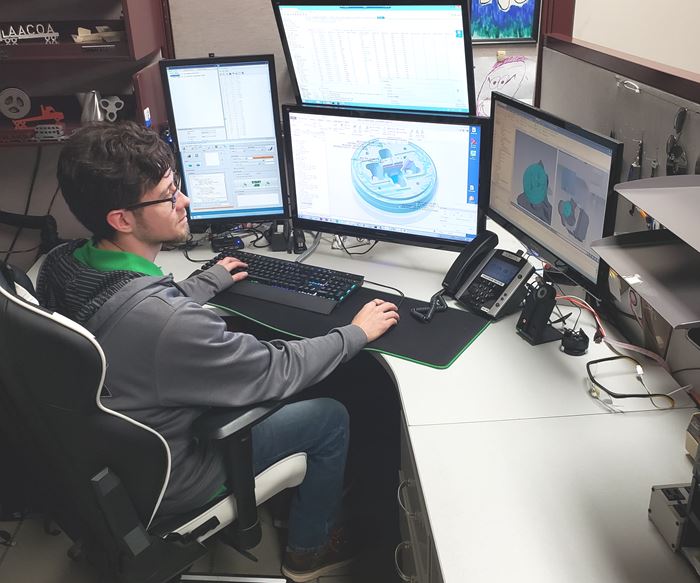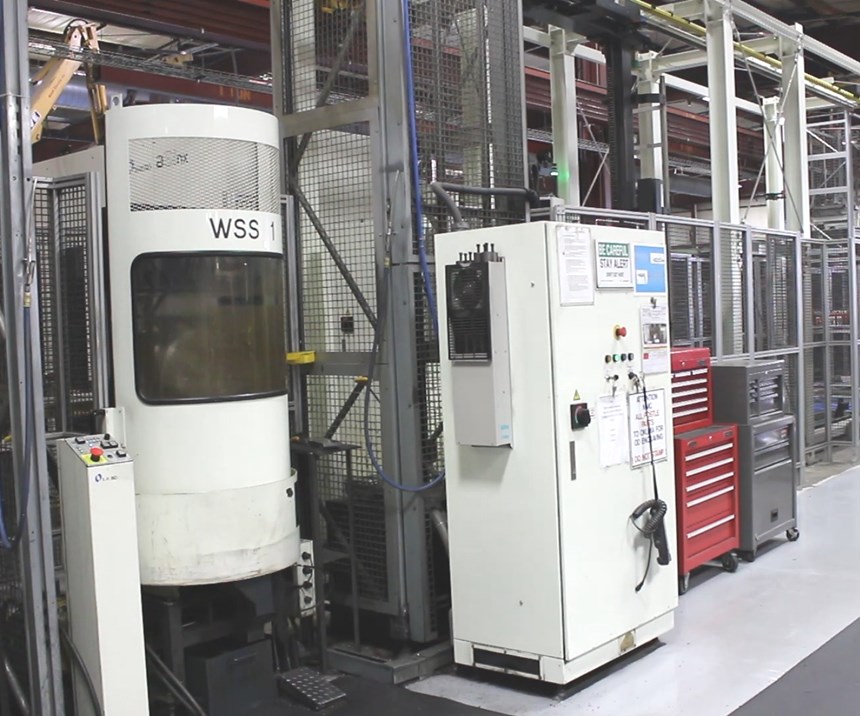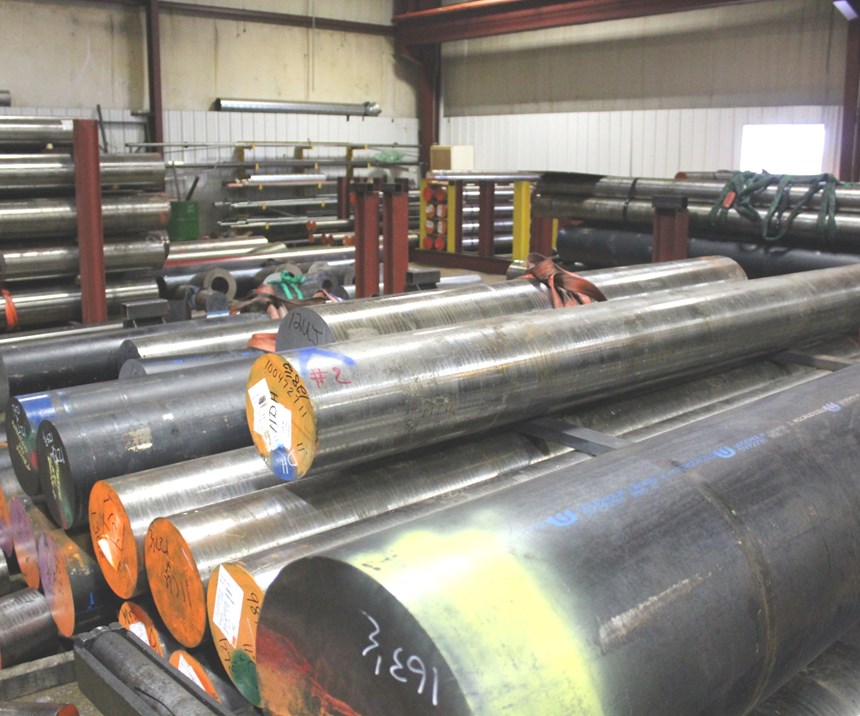Automating Small NC Programming Tasks Pays Off Big Over Time
What started as a few Java macros the programmer whipped up to make life easier has grown to a shop-wide file management system integrated into other software, such as Vericut.
Share





To many in manufacturing, “automation” means fleets of robots, unattended machine tools and autonomous material handling systems. But what if there were another type of automation, one that provides similar results—the ability to produce more with less—yet looks very different from electromechanical systems?
Josh Bryant, a programmer, will readily agree that there is.
Starting out, he never intended to work in a machine shop. But shortly after earning his bachelor’s degree in computer science, he received a call from his friend, Andrew Rowe of Thumb Tool & Engineering (part of the Gemini Group). “Hey, we’re looking for someone to help out with some solid modeling,” he said. “You interested?”
A manufacturer of extrusion dies and assorted tooling, Bad Axe, Michigan-based Thumb Tool machines parts ranging to 42 inches in diameter, 72 inches long and weighing up to 33,000 pounds.
It wasn’t long after Mr. Bryant settled into his new position as CNC programmer that he grew impatient with some of its more mundane tasks around NC program verification. And since he is a Java programmer by training, he decided to write a series of macros that would automate some of these tasks, freeing him to work on other, more meaningful activities. “Others saw what I did and liked it, which basically sparked a ‘what else can we do?’ revolution within the company,” he says.
My day is never the same. I’m always fixing something or working on something different. It challenges me in ways I never expected. I think that somewhere along the way, I fell in love with manufacturing.”
Homegrown Automation
What began as a utility to verify basic information about the shop’s NC programs soon blossomed into a full-blown file management system that is now the shop’s go-to tool for monitoring job status, documenting production issues and resolutions, and so on.
As Thumb Tool management saw their scrap rates fall and analytical capabilities rise, they charged Mr. Bryant with integrating his burgeoning file management utility with other software packages. He started with CGTech’s Vericut software, which the team of NC programmers uses to simulate tool paths on the company’s assortment of Makino, Okuma and Mazak machine tools.
“What I do is generate the actual Vericut project code through a custom job interface,” Mr. Bryant says. “All the programmers have to do is click a green button on an internal webpage, and the software connects to Creo (a 3D CAD program from PTC), extracts the solid model and runs Vericut in the background for them. It also does a preliminary check of various program values, so there’s no time wasted on simulating tool paths for a job that won’t fit in the machine or doesn’t have enough tools in the magazine.”
Mr. Bryant admits that, on new jobs at least, the time savings isn’t tremendous—what would have taken several minutes in Vericut to set up is now an automated 10 seconds or less. When multiplied by the 30 to 50 new jobs each week, however, he estimates this simple function saves several hours each week for the programming team, while eliminating mistakes and missteps. “The biggest benefit has been on repeat work, because I added the logic to automatically regenerate whatever we did previously—the programmers don’t even have to touch them, which easily saves half an hour or more per job.”
Software Made to Be Tweaked
None of this surprises Vericut Product Manager Gene Granata, who says Vericut's non-proprietary file formats and innate automation capabilities make it relatively easy to avoid some of the “click work” that would otherwise occur during a typical NC programming project. “Many organizations have figured out, ‘Hey, if I create a little Java program or C# script that reads the data coming out of my CAM system, I can create the necessary setup files and launch Vericut all with a single button push.’”
Mr. Granata is quick to point out that while custom interfaces and automation routines such as Mr. Bryant’s may make the programming department more efficient, less tech-savvy shops can enjoy the benefits of automation just by using Vericut’s out-of-the-box capabilities. These include batch file processing, command-line arguments, enhanced software control through parsing of statements made in the post-processed code and more. According to Mr. Granata, one of Vericut’s biggest strengths is its openness to customer requests for features and tweaks. The software has incorporated thousands of such requests over the past few decades, he says.
Learning from the Process
Vericut’s capabilities notwithstanding, it’s clear that Mr. Bryant’s homegrown software system has gone far beyond his original intent. If he had to do it all over again, he says he would have done a more thorough job upfront of documenting Thumb Tool’s engineering and programming processes, finding their commonalities and then simplifying those process wherever possible. Doing so would have made the task of automating them simpler as well.
As for his unexpected career path with a company that machines billets of metal the size of coffee tables, Mr. Bryant says he has no regrets. “My original plan was to get into a programming firm, maybe on the medical side,” he says. “But I’ve found that after becoming part of the manufacturing industry, I’m intrigued by everything I see. My day is never the same. I’m always fixing something or working on something different. It challenges me in ways I never expected. I think that somewhere along the way, I fell in love with manufacturing.”
Related Content
Automated CAM Programming – Is Your Software Really Delivering?
A look at the latest automation tools in Autodesk Fusion 360 software and how forward-thinking machine shops and manufacturing departments are using them to slash delivery times and win more business.
Read More5 Tips for Running a Profitable Aerospace Shop
Aerospace machining is a demanding and competitive sector of manufacturing, but this shop demonstrates five ways to find aerospace success.
Read MoreThe Power of Practical Demonstrations and Projects
Practical work has served Bridgerland Technical College both in preparing its current students for manufacturing jobs and in appealing to new generations of potential machinists.
Read MoreTips for Designing CNC Programs That Help Operators
The way a G-code program is formatted directly affects the productivity of the CNC people who use them. Design CNC programs that make CNC setup people and operators’ jobs easier.
Read MoreRead Next
Building Out a Foundation for Student Machinists
Autodesk and Haas have teamed up to produce an introductory course for students that covers the basics of CAD, CAM and CNC while providing them with a portfolio part.
Read More5 Rules of Thumb for Buying CNC Machine Tools
Use these tips to carefully plan your machine tool purchases and to avoid regretting your decision later.
Read MoreRegistration Now Open for the Precision Machining Technology Show (PMTS) 2025
The precision machining industry’s premier event returns to Cleveland, OH, April 1-3.
Read More
































